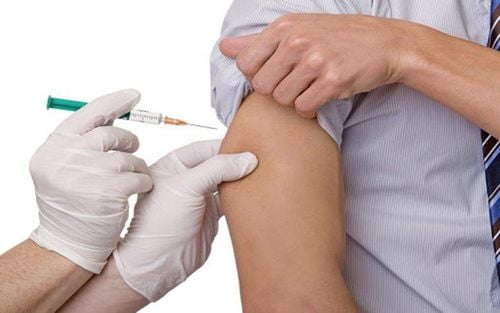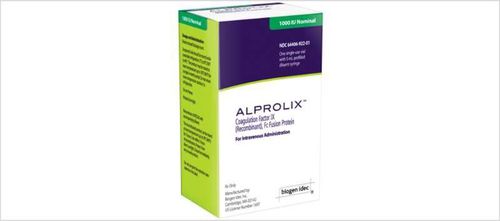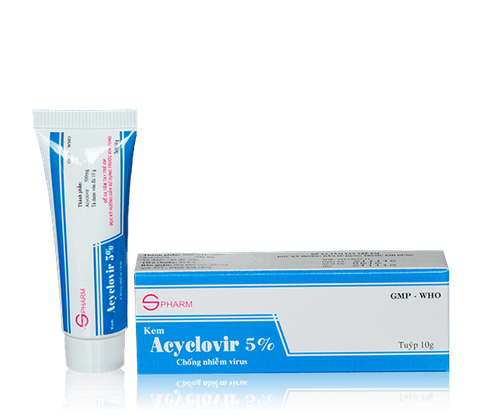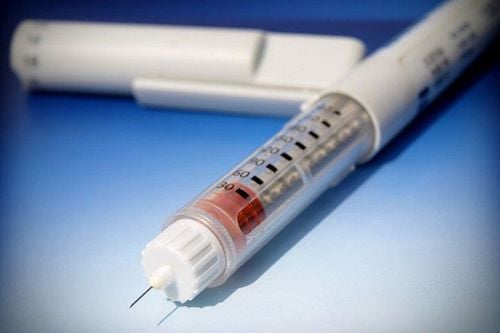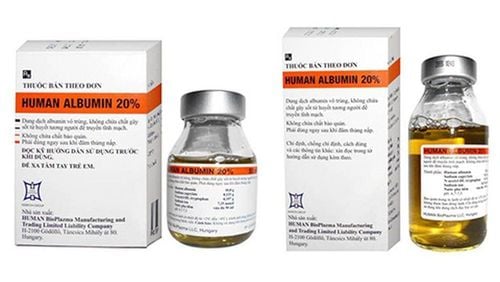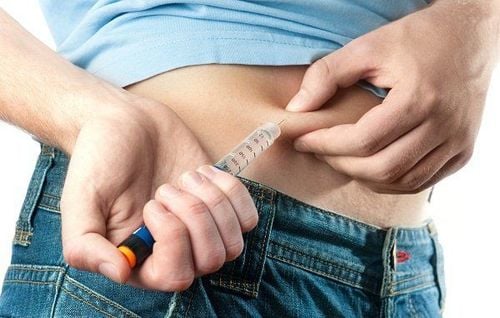This is an automatically translated article.
The article was professionally consulted with Master, Doctor Phan Ngoc Toan - Resuscitation - Emergency Doctor - Vinmec Danang International General Hospital.In medicine, drugs are used through many different routes such as oral, injection, infusion, topical application, .... of which the most common are still oral and injectable. Almost all patients can self-administer medication, while injections are mostly performed by medical staff.
1. Purpose of injection techniques
In most body tissues and cavities, fluids can be introduced through injection procedures. In fact, there are several tissues commonly selected for drug delivery:In the skin. Subcutaneous: in between the skin and the muscle. In muscle. Intravenous. The choice of tissue for drug delivery depends on the following factors:
1.1. Point
The injection technique is indicated in the following cases:Emergency patient, serious illness, need quick action. The patient vomited a lot, so he could not take the medicine. Patient is ready for surgery. The intradermal route is often used for diagnostic purposes, testing for allergic reactions. Sometimes this technique is used in prophylaxis such as vaccination and therapy.
Subcutaneous injection, intramuscular injection, intravenous injection are mainly used in treatment, but can also be used for diagnostic purposes.

1.2. Drug absorption rate
Except for the intradermal injection technique, the remaining injection techniques allow the injection solution to diffuse or be delivered directly into the circulatory system. In which intravenous technique, the drug will be put directly into the venous blood, so the drug will have an immediate effect. Due to the difference in histology of muscle tissue and subcutaneous tissue, the speed of drug penetration into the blood will be in the following order: intravenous injection is faster than intramuscular injection, then subcutaneous injection, and finally intradermal injection.1.3. Number of injections
Because tissues have different absorptive capacities, the amount of drug delivered to the tissues in a single injection is different. Specifically as follows:Intradermal injection is limited to 0.1ml. Intramuscular injection is limited to 3 - 5ml.
1.4. Properties of injectable drugs
Oily drugs are administered intramuscularly only. Iron-containing drugs, if injected under the skin, can cause necrosis and inflammation. Hypertonic fluids can only be administered intravenously.1.5. Steps to administer injections
Always test before injection: Check the right patient. Check the correct medication. Check the correct dosage. Check for correct technique. Check at the right time. Infection prevention: injection is the introduction of drugs into the body through an unnatural route, the natural protective barrier of the skin and muscles is destroyed, so it must be done with sterile equipment and aseptic manipulations. The spread of blood-stained needles, syringes and cotton should always be considered. Always store needles and syringes in separate containers. Do not leave the needle bare, because it is very likely that you will be punctured by the needle, so the needle is no longer usable.1.6. Things to pay attention to
Medical staff need to perform 3 checks and 5 matches or 5 corrects during the injection of the patient.3 Checks include: Checking the patient's name. Check the drug name. Check dose. The 5 collations are: Reconciling the number of beds, the number of rooms. Compare drug labels. Compare drug quality. Compare injection routes. Compare the shelf life of the drug. The correct 5 includes: Correct patient. Right medicine. Right dose. Correct route of injection. On time.
1.7. Basic injection technique
1.7.1. Patient reviews
Identify the patient through the following factors:Perception of the patient. Patient age. The patient's subcutaneous fat layer is thick or thin. How does the patient exercise? Weakness, paralysis or normal mobility? Drug type and quantity used, mixed drug? Does the patient have allergies?

1.7.2. Prepare the patient
Match the right patient. Explain to the patient to understand to cooperate. Appropriate patient position. If the patient is seriously ill, help is needed.1.7.3. Preparing instruments
Copy of drug ticket. Take medicine as prescribed, check for the first time. Wear a mask, wash your hands regularly. Prepare the injection device tray: Spread a towel over a clean tray. Select the appropriate syringe for the amount of drug to be injected. Select the appropriate needle for the injection route and injection site. Take the medication needle. Cotton swabs, alcohol iodine to disinfect the skin. Ball/clamp. Anti-shock pill box. Garage rope. Clean gloves. Bottle of quick hand sanitizer. Single-sided, yellow hard plastic sharp medical waste bin. Yellow medical waste bag. Green garbage bag containing domestic waste.1.7.4. Carrying out the drug taking technique
Prepare the injection:Take the medicine from the ampoule: Disinfect the tip of the ampoule, double check. Cut the tube if necessary. Use a dry cotton ball to wipe and break the ampoule. Withdraw the drug into the syringe, without touching the needle body and the inner barrel of the syringe. Check the medicine for the 3rd time, then throw the tube cover in the trash. Close the needle securely, place the syringe on top of the slip in the secure injection tray. Take medicine from the vial: Open the vial cap, disinfect, check the second time. Take water for injection into the pump with a needle. Insert the needle through the vial cap, injecting distilled water into the vial. Aspirate the air back, then safely remove the needle and shake the vial until the medicine is completely dissolved. Insert the needle and inject air into the vial and draw the medication into the syringe. For the 3rd drug test, put the vial in the trash. Replace the appropriate needle. Close the needle securely, place the syringe on top of the slip into the secure injection tray.
2. Basic injection techniques in medicine
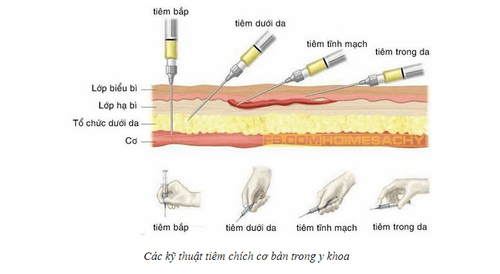
2.1. Intradermal injection technique (ID)
Intradermal injection is the technique of injecting a prescribed amount of medicine according to the doctor's orders into the epidermis. Here, the drug is absorbed into the bloodstream and has a very slow effect.Intradermal injection technique is indicated in the following cases:
BCG vaccination against TB in infants. Do the Mantoux reaction. Test the body's reaction to drugs, mainly with antibiotics, drugs that cause anaphylaxis such as Penicillin, Streptomycin, .. Needle: size 26-27G, length about 0.6-1, 3cm.
Injection site: usually on the shoulder blades (Delta muscle) or on the upper third of the inner forearm.
The injection angle is about 15 degrees from the skin surface.
The injection technique is as follows:
Match the right patient, inform and explain. Expose the injection site. Determine the injection site. Wear clean gloves. Disinfect the injection area with alcohol cotton in the direction from the inside to the outside about 5cm, in a spiral. Sanitize your hands again. Remove any air bubbles from the syringe. Tighten the skin of the injection site, with the bevel side of the needle facing up, insert the needle at an angle of about 15 degrees to the skin surface. Inject 0.1ml of the drug, at the injection site will swell. Quickly withdraw the needle in the direction of insertion. Use a pen to circle the injection site if test reaction, after 15 minutes check. Remove gloves. Instruct the patient not to touch the injection site. Inform and explain to the patient that the injection is complete. Clean up tools and record.
2.2. Subcutaneous (SC) technique
Subcutaneous injection is a technique where a drug is injected into the loose connective tissue under the skin.Subcutaneous injection technique is indicated in the following cases:
Insulin injection. The case wants to let the drug slowly infiltrate into the body to promote the effect slowly. The subcutaneous injection technique is contraindicated in the following cases:
Oily drugs that are difficult to dissolve. The patient's skin problem is not favorable for injection. Needle: use a 25G needle, about 1 - 1.6cm long.
Injection angle: about 45 degrees from the surface of the skin, if fat patients can inject at an angle of 90 degrees, and if thin patients can inject at an angle of 15 - 30 degrees relative to the skin surface.
Common injection site:
2 shoulder blades 1/3 outside front of thigh Around navel. Subcutaneous injection technique:
Match the right patient, inform and explain. Expose the injection site. Determine the injection site. Wear clean gloves. Disinfect the injection area with alcohol cotton in the direction from inside to outside about 5cm, in a spiral. Sanitize your hands again. Remove any air bubbles from the syringe. Pinch the skin of the injection site, insert the needle at an angle of about 45 degrees to the skin surface. Pull up the plunger to see if there is blood, if there is blood, adjust the needle (withdraw the skin or puncture a little), check for no blood, then inject the drug slowly and observe the patient's face. Quickly withdraw the needle in the direction of insertion. Place a dry cotton ball on the injection site and massage gently. Remove gloves. Inform and explain to the patient that the injection is complete. Clean up tools and record.
2.3. Intramuscular (IM) technique
Intramuscular injection is the technique of delivering a drug into the muscle - in the muscle. When using this technique, the drug will work faster than subcutaneous injection.Intramuscular injection is indicated in cases of isotonic solutions such as:
Quinine, Ete. Oil solution: long-soluble, easy to cause pain. Colloidal solutions, mercury salts, silver salts, hormones, antibiotics... are slow to dissolve and cause pain. All drugs administered subcutaneously can be administered intramuscularly except caffeine. Intramuscular injection is contraindicated in the case of drugs that cause tissue necrosis such as Ouabain, Calcium chloride,...
Needle: use a 21-23G fixed needle, about 2.5 - 4 cm in length.
Injection angle: about 90 degrees from the skin surface.
Injection site:
Superficial intramuscular injection: Delta muscle. The amount of medicine should not exceed 1ml. Do not inject oil. Do not use for underdeveloped Delta muscles: children < 2 years old. Deep intramuscular injection: Thigh: in the outer third of the thigh. The amount of drug injected here should not exceed 3ml. Butt: the upper and outer 1/4 hook is the anterior upper iliac spine. The amount of injection here is not more than 3-5ml. Intramuscular injection technique:
Match the right patient, inform and explain. Expose the injection site. Determine the injection site. Wear clean gloves. Disinfect the injection area with alcohol cotton in the direction from inside to outside about 5cm, in a spiral. Sanitize your hands again. Remove any air bubbles from the syringe. Stretch the skin of the injection site, insert the needle at an angle of about 90 degrees to the skin surface. Pull up the plunger to see if there is blood, if there is blood, adjust the needle (withdraw the skin or puncture a little), check for no blood, then inject the drug slowly and observe the patient's face. Quickly withdraw the needle in the direction of insertion. Place a dry cotton ball on the injection site and massage gently. Remove gloves. Inform and explain to the patient that the injection is complete. Clean up tools and record.
2.4. Intravenous (IV)
Intravenous injection is a technique of delivering drugs directly into a vein.Intravenous injection technique is indicated in the following cases:
Emergency patient. Severe illness requires quick action. Patient is exhausted. Patients with mucosal lesions, do not absorb or the drug is destroyed by the gastrointestinal tract. Patients can not take medicine, vomit a lot, patients are about to operate, patients with mental illness do not cooperate. Intravenous injection is contraindicated in the following cases:
Absolutely contraindicated for burns and infections. Relative contraindications for terminal limb paralysis, edema, avoidance of joints. Needle: use needle size 19 - 21G, length about 2.5 - 4cm.
Angle of injection: usually an angle of 30-40 degrees from the skin surface, depending on the location of the injection vein.
Injection site: are peripheral veins, priority is to choose veins that are large, clear, less mobile, soft, not near joints.
Injection technique:
Match the right patient, inform and explain. Expose the injection site. Determine the injection site. Wear clean gloves. Tie the gauze rope at the top of the injection site about 5-10cm. Disinfect the injection area with alcohol cotton in the direction from inside to outside about 5cm, in a spiral. Sanitize your hands again. Remove any air bubbles from the syringe. Tighten the skin of the injection site, with the bevel of the needle facing up, insert the needle at an angle of about 30-40 degrees from the skin surface into the vein. Pull up the plunger to see if there is blood, if there is no blood, adjust the needle (withdraw the skin or puncture a little), check for blood, remove the tourniquet, then inject the drug slowly and observe the patient's face. . Quickly withdraw the needle in the direction of insertion. Place a dry cotton ball on the injection site and massage gently. Remove gloves. Inform and explain to the patient that the injection is complete. Clean up tools and record.
2.5. Final steps after performing basic injection techniques
Clean up equipment: Return the pill slip to the correct place or put it in the waiting box for the next time. Handle injection equipment in accordance with sterilization and sterilization procedures. Other tools are returned to their original place such as screens,... Record records, medical records: Record the date and time of injection. Write down the drug name, dose, route of injection and injection site. Record the patient's reaction, if any. Specify the name of the person performing. Above are 4 basic injection techniques commonly used in medicine. Most of these techniques are performed by trained medical personnel. However, there are also some cases where patients can do it themselves after being instructed by medical staff such as patients injecting insulin daily,...Please dial HOTLINE for more information or register for an appointment HERE. Download MyVinmec app to make appointments faster and to manage your bookings easily.





